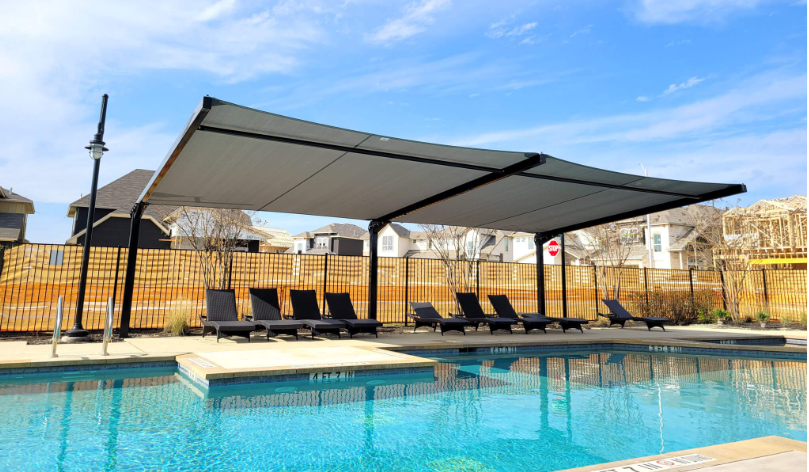Is a Permit Needed for a Shade Structure
Before you plan to enhance your outdoor space with a shade structure or sail, consider the regulations that govern such installations. Navigating zoning laws and acquiring permits can be complex, depending on local municipal codes. While some regions may require formal approval for any construction, others might not enforce strict controls on minor additions like shade sails.
Understanding these details ensures compliance and helps avoid potential legal issues as you upgrade your property’s comfort and aesthetic appeal.
Understanding Shade Structure Installations
Before installing your outdoor shade structure, you must understand if a permit is necessary. Local building codes are in place to guarantee safety and adherence to zoning laws. These regulations may vary based on the size or attachment of the installation; large or anchored structures typically need permits, while small detached ones might not.
The location’s zoning department provides vital information tailored to your property’s criteria, considering factors like dimensions, height restrictions, and acceptable materials. If planning for attached shades that impact an existing building’s integrity, expect stricter scrutiny. Engage with local experts such as architects who grasp these requirements thoroughly. They’ll navigate you through, avoiding legal hassles or fines later on.
Furthermore, conforming installations add value by assuring future occupants about structural quality and regulatory compliance. When considering whether permits apply to your shade sails project, remember to check specifics related to design size within community guidelines first. It saves time and fosters safe completion, fitting into the neighborhood aesthetic seamlessly.
Assessing Local Zoning Regulations
When you’re planning to install a shade structure, one of the first questions you’ll probably ask is, “Do I need a permit for a shade structure in my area?” The answer depends heavily on local zoning regulations, which can be surprisingly complex.
For example, in residential zones like Falls Church’s “R” areas:
- Different types of structures are allowed depending on the location.
- Apartment buildings are only permitted in certain sections near commercial corridors.
Zoning laws also set clear limits on:
- Minimum lot sizes
- Maximum building heights
- The distance structures must sit from the property lines
Another key detail is the distinction between:
- “By right” developments, which staff can approve automatically if they meet all requirements
- “Conditional use” projects, which require public hearings or council votes before moving forward
To put it in perspective, Montgomery County’s zoning code alone spans nearly 400 pages—a reminder that rules can be overwhelming without guidance.
Zoning serves several purposes:
- It keeps developments compatible with the surrounding neighborhoods
- It gives the community a voice in new construction
- It helps ensure safety and proper land use
But in practice, enforcement and interpretation often vary. Some areas have more resources to monitor projects closely, while others rely on complaints or spot checks. That’s why it’s so important to check local codes early and confirm exactly what applies to your specific property before you start building.
Permit Requirements for Outdoor Shades
When installing a patio cover, you need to secure a building permit. This ensures your structure meets local construction codes and safety standards. In Arizona, for example, permits might cost up to $500. However, prices vary based on project specifics and location.
Typically required for structures attached or sometimes detached from homes, these regulations aim at ensuring safe use post-construction. To get this permit, research your city’s codes, draft detailed plans of the shade, including materials and dimensions used, and then consult with your municipality for precise costs.
Consider hiring a licensed contractor who can navigate obtaining permits efficiently if handling it yourself seems daunting.
Navigating Building Codes for Structures
Before you start construction, it’s important to check whether your project meets local building codes.
These rules cover everything from materials to design and safety features. They exist to protect people and property from risks like collapse or fire.
When you talk to your local code enforcement office, check requirements such as:
- Structural stability: Can your shade structure handle strong winds or heavy snow?
- Material standards: Some areas limit what materials you can use, especially in fire zones.
- Energy efficiency: Certain locations require designs that help reduce energy use.
- Environmental impact: Coastal zones and historical districts often have stricter rules to protect the surroundings.
Following these codes isn’t just about avoiding penalties. It gives you peace of mind that your structure is built safely and legally.
Skipping this step can lead to fines or being forced to take down the entire project. A little research upfront saves money, time, and stress later on.
Installation Process of Shade Sails
If you find out you don’t need a permit, you’re ready to start installing your shade sail.
Begin by picking strong anchor points like sturdy posts or solid walls. These spots must be tough enough to handle tension and hold up in wind and rain.
Here are the key steps to follow:
- Use quality hardware: Choose materials that resist rust and corrosion.
- Drill and secure: Attach mounting brackets or plates firmly to your anchors.
- Add tension devices: Connect turnbuckles or other tools to pull the fabric tight.
Take time to measure carefully so the sail stretches evenly. This helps prevent sagging and keeps your coverage consistent.
If you’re installing the sail above head height, always use a sturdy ladder and follow safety precautions. If the project feels too tricky, consider hiring a professional installer.
After everything is up, check your shade sail regularly. Look for fraying edges, loose hardware, or spots where the tension isn’t even. Catching these issues early can extend the life of your setup and keep it safe.
Exemptions to the Permitting Process
Not every shade structure needs a permit. In many areas, small or temporary setups can be installed without formal approval.
Here are some common situations where you might be exempt:
- Size: If your structure is small and doesn’t cover much space, you may not need a permit.
- Duration: Temporary installations used only for part of the year often qualify for exemptions.
- Mobility: Structures on wheels or those that can be easily moved sometimes don’t require permits.
- Agricultural use: Shade structures used for farming or nurseries can have different rules.
Even with these exceptions, the rules change from place to place. It’s always smart to check with your local building department or zoning office before you start any project.
Taking time to confirm the details helps you avoid surprises, fines, or the hassle of having to take your shade structure down later.
Finalizing Your Shade Project Legally
Before your new shade structure becomes a reality, it’s crucial to address legalities. First, check with your city or county building department regarding permit requirements; they vary by location. Often, a permit hinges on the size and type of structure you’re planning.
Don’t overlook homeowners’ association rules if applicable. Their approval may be necessary, too. Secure any needed permits before construction begins to avoid penalties or having to dismantle your project later on. If unsure about the regulations, consider hiring a local contractor familiar with jurisdictional nuances who can navigate these for you effectively.
Remember that proper documentation not only ensures compliance but also the safety and durability of your outdoor enhancement.
Navigating local zoning regulations and obtaining permits can be complex when installing shade structures. Your geographic location, the type of structure you plan to install, and its size all play crucial roles in determining permit requirements. You should always check with your local building authority before proceeding with installation to ensure compliance with regional codes.
For your convenience, ShadePro offers expert assistance on these matters as part of our service commitment to make sure that your new addition meets all necessary guidelines for a hassle-free enjoyment of added comfort outdoors.

















